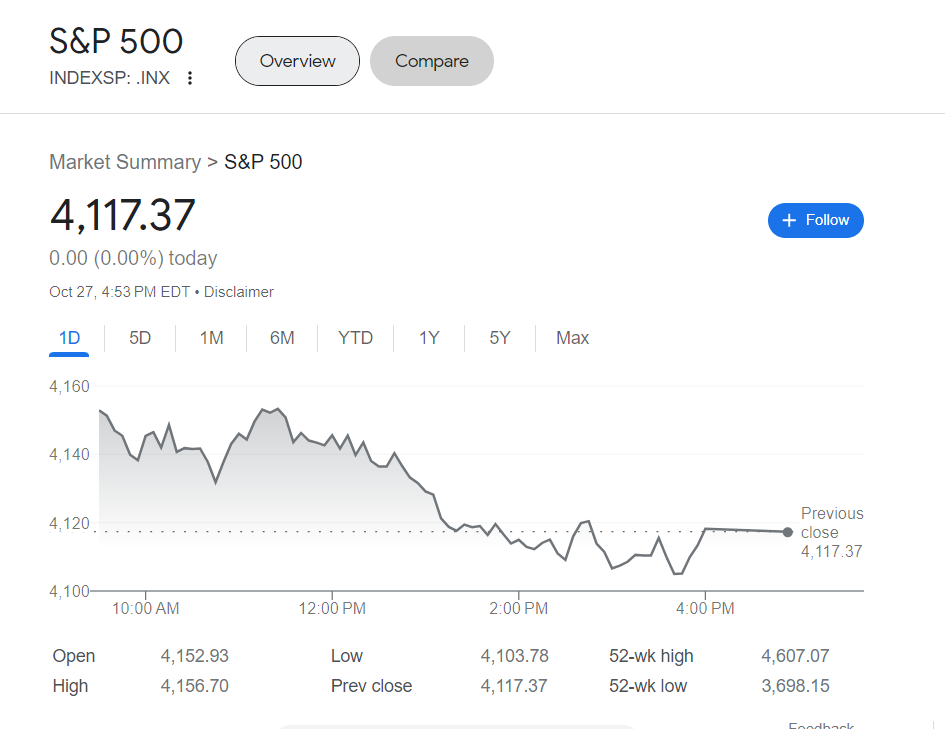You can consider certain stock prices, but a 5% return on Treasurys is also favorable.

A lot of individuals enjoy experiencing some level of fear.
The main purpose of Halloween has always been this. The eerie customs might even act as a precaution, a method to minimize chaos in case gloomier times are approaching.
When fear starts to affect someone’s savings, retirement fund, or investment portfolio, things become more complicated. In particular, the fear of potential chaos has been particularly strong in October, resulting in a significant decline in the S&P 500 index. This decline caused the index to drop below the 4,200 level, which led to a correction on Friday. Additionally, the Nasdaq Composite Index also experienced a decline of at least 10% from its peak during the summer.
Furthermore, a severe sell-off in the bond market has significantly increased the yields of the 10-year and 30-year Treasury bonds BX:TMUBMUSD10Y, with both recently approaching the 5% mark. This spike in yields can result in higher borrowing expenses for the American economy and may disrupt financial markets.
According to Rich Steinberg, the chief market strategist at The Colony Group, who manages $20 billion in assets, the magnitude of numbers is significant. He explained that investors are currently grappling with the dilemma of finding suitable investment opportunities and seeking safe havens for their money.
Steinberg believes that when individuals become consumed by fear, their perception of reality can become distorted. He suggests that investors can achieve success by earning an approximate 5.5% return on shorter term Treasurys without risk, while also considering stocks that align with their preferred price range.
He mentioned that this is the point where investors can truly benefit in the long run, as long as they have sufficient funds to withstand possible extended periods of volatility.
Investors are becoming more concerned about the U.S. government’s spending habits, as the Treasury Department plans to announce a borrowing requirement of around $1.5 trillion to cover a significant budget deficit. This would result in an influx of Treasury bonds into an already unstable market, which could potentially impact the functioning of financial markets.
Increasing bond yields in the United States pose a risk of amplifying the cost for the federal government to manage its debt, while simultaneously creating obstacles for businesses by triggering job cuts and increasing the likelihood of defaults.
Fed decisions, yields
Following its two-day meeting, it is anticipated that the Federal Reserve will maintain its policy interest rates unchanged on Wednesday, keeping the rate within the range of 5.25% to 5.5%, which is the highest it has been in 22 years.
The real excitement usually happens during the afternoon press conference led by Fed Chairman Jerome Powell after every interest rate decision.
Bryce Doty, a senior portfolio manager at Sit Investment Associates, expressed confidence that the Federal Reserve will not raise interest rates again in this current period. He believes that this will create a favorable situation for bond funds in the year 2024, especially since starting yields are currently higher than in previous years.
However, Doty also identifies two potential factors that could disrupt markets. A significant increase in Treasury debt being issued could flood the market with supply, resulting in higher yields and potentially prompting the Federal Reserve to resume its bond purchase initiative, he explained.
Furthermore, the Israel-Hamas clash has the potential to escalate, leading to an increase in global warfare that may result in a surge in demand for high-quality assets and subsequently lower bond yields in the United States.
Given this context, Doty proposes investing in bonds with a longer duration such as BX:TMUBMUSD03M, as longer-term interest rates surpass shorter-term rates, causing the Treasury yield curve to become steeper. Doty states that now is the opportune moment for investors to continue extending their investment along the curve as it becomes steeper.
Keith Lerner, who holds the position of chief markets strategist at Truist Advisory Services, stated that yields have presented the greatest difficulty for the stock market. He also observed that stocks have been unsteady ever since the 10-year Treasury yield exceeded 4% in July.
Lerner noted that although there was a significant decrease of approximately 17% in the popular “Magnificent Seven” stocks, it is not as severe as the decline seen in other sectors of the S&P 500 index, such as real estate, where the retreat is closer to 20%.
“He mentioned that we have experienced a satisfactory reset, also noting that decreased stock prices offer investors slightly improved compensation for the upcoming uncertainties.”
Cameron Brandt, director of research at EPFR, expressed that the current investment environment is exceptionally difficult, comparing it to a period of time when challenges were prevalent. EPFR is responsible for monitoring the flow of funds across different types of assets.
Given the context, he anticipates that investors will hold a greater amount of cash reserves until the end of this year compared to previous periods.
The Dow Jones Industrial Average, also known as DJIA, decreased by 2.1% over the week and ended at its lowest point since the banking crisis in March. The S&P 500 experienced a 2.5% decrease throughout the week and the Nasdaq Composite dropped by 2.6%.
There are several important events scheduled for next week, including the announcement of Treasury borrowing and the Federal Reserve’s decision on Wednesday. Additionally, the Labor Department will be releasing the October jobs report on Friday.




